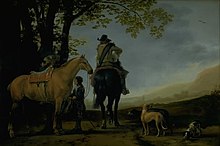アブラハム・ファン・カルラート
| アブラハム・ファン・カルラート Abraham van Calraet | |
|---|---|
 ファン・カルラート作『2頭の馬』ダリッジ絵画館(蔵) | |
| 誕生日 | 1642年10月12日(洗礼日) |
| 出生地 | ドルトレヒト |
| 死没年 | 1722年6月11日 |
| 死没地 | ドルトレヒト |
アブラハム・ファン・カルラートまたはアブラハム・カルラート(Abraham van Calraet または Abraham Calraet 、姓は Kalraatとも、1642年10月12日(洗礼日)- 1722年6月11日)はオランダの画家、版画家である。風俗画や静物画、牛や馬などの動物画を描いた。
略歴[編集]
ドルトレヒトで生まれた。父親は木彫家で商業を学ぶ傍ら、父親の木彫の仕事を手伝った。後に画家に転じ、1670年頃には静物画を多く描いていた。1680年にドルトレヒトの画家、コルネリス・ビスコップ(Cornelis Bisschop:1630-1674)の娘と結婚した[1]。カルラートは生涯、ドルトレヒトで活動した。弟のバレンツ(Barent van Kalraet または Barent Pietersz Calraat:1649-1737) もまたカルラートから絵を学び、後にアルベルト・カイプの弟子になった。
アブラハム・ファン・カルラートもアルベルト・カイプの影響を受けており、さらに作品にカイプと同じく「A.C」とサインしたことが多かったことにより、作品の多くが、アルベルト・カイプの作品とされることになった。20世紀になって、美術コレクター、アブラハム・ブレディウス(Abraham Bredius:1855–1946)によって、カイプの作品とされてきた静物画がカルラートの作品であることが示され[2]、さらに研究者によって多くのカルラートの作品がカルラートの作品と同定されている。
作品[編集]
-
「貝殻」
-
馬丁のいる風景画
-
栗毛の馬のいる風景
-
静物画
-
馬の手綱を持つ少年
-
静物画
-
桃と葡萄のある静物画
脚注[編集]
参考文献[編集]
- Alan Chong, Grove Art Online, Oxford University Press, 1998 (ISBN 9781884446054)
- Ian Chilvers, The Oxford Dictionary of Art, Oxford University Press, 2004 (ISBN 9780198604761)
- Ian Chilvers, The Oxford Dictionary of Art and Artists, Oxford University Press, 2009 (ISBN 9780199532940)
- Hoogsteder, Cuyp or Calraet ? Two horse painters from Dordrecht with the monogram A. C., The Hoogsteder Journal, Numéro 10, 2004
- Charles Dumas, Fred G. Meijer, Sander Paarlberg, Kennerschap Bredius: geen Cuyp, wel Calraet, Stichting Bredius Genootschap, 2015, 117 p. (ISBN 9789048438143,)
- A. Bredius, The Still-Life Painter Abram Calraet, The Burlington Magazine,vol. xxx, 1917 (lire en ligne [archive]), p. 172-179 pour le texte
- A. Bredius, The Still-Life Painter Abram Calraet, The Burlington Magazine,vol. xxx, 1917 (lire en ligne [archive]), p. 172-179 pour l'image
- A. D. Chong, Aelbert Cuyp and the Meanings of Landscape, New York University, 1992, 511 p. (lire en ligne [archive]), p. 502-529







